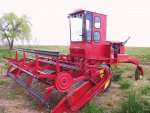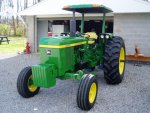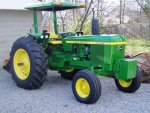Farmwithjunk
Member
US built and marketed 135's had a red dash. The 150 was only sold in North American markets. Here's a little "informal history" of the 150.
The 150 was the result of an experiment by Massey Harris engineers that started about the time of the Ferguson/Massey Harris merger. Harry Ferguson was opposed to building a bigger tractor. He was convinced the market would continue to support tractors from the TO-20/TO-30/TO-35 lineage. Massey Harris design engineers wanted bigger and higher horsepower models to go head to head with their primary competition, Ford. MH engineers were responsible for the MF65 about to be released. There was an MF75 on the drawing board that never saw production, then the MF85/90 series. When the two companies first began to merge, MH saw a need for a true row crop version of the venerable 20/30/35 series. With some of the design basics of the 65 being used, they took the engine and transmission of the 35 and went to work.
At first, shortly after the merger, the two names stayed seperated. There were still Massey Harris dealers and Ferguson dealers, at times even competing directly against each other. Their product lines were somewhat different but beginning to blend.
Massey Harris dealers coveted the successful 20/30/35 series. What they got was the Massey Harris 50. That took the 35 drivetrain and added the front axle and axle bolster, sheet metal, cooling system, fuel tank, steering system, dash (along with its better instrumentation) and engine air filter location of the yet to be released MF65 and morphed a "new" tractor. Ferguson dealers, not to be left out, got a very simular version, the Ferguson F-40. The only differences, besides badging, was a slightly different grill and hood. The biggest difference between the 35 and the 40/50 line-up was the 40/50 was available in a high clearance row crop version known as the "high arch". It was essentially the same tractor with 38" rear wheels instead of the 24" or 28" wheels on the "standard". High Arch models were available in wide front, or narrow front with single or double wheels. The heavier front axle and bolster gave the 40/50 a longer wheel base than the 35. (Approx. 9") That made the new tractor handle heavy rear mounted implements better. The bolster added a solid mounting point for front end loaders as well as mid-mounted cultivators. The longer wheelbase made the tractor respond to wider wheel track settings, providing a more stable tractor. With the heavier straight axle of the 40/50, gone were the radius rods of the swept back axle of the 20/30/35.
MH50's were in production for 2 years. (late 1955, 1956, and early 1957) F-40's were built for less than 2 years. (early 1956 to mid 1957) With the change in brand name in 1957, to Massey Ferguson, the MF 50 was released. Sometime in 1958, the 50's powerplant, the Continental Z134 4-cylinder gas engine got a partner, the legendary Perkins AD3-152 3-cylinder diesel came on board. Gas models were rated at 32 hp. Diesels were now 38 hp.
By the time the MF35/50/65/85 models hit the fields, Massey Ferguson was beginning to develope their first "in house" designed models. The DX series. Later designated as the 100 Series, these were the tractors that put Massey Ferguson on the map. The 35 became the legendary 135. The 50 went on to become the 150. Hydraulic systems, especially the draft control system was upgraded. Bigger cooling system was added, a new dry air filter replaced the old oil bath filter. All new sheet metal covered the tractor. The 150 came standard with flat-top fenders and full instrumentation that were options on the 135. A deluxe seat was added, along with PAVT (Power adjustable variable tread) rear wheels were standard. In Univ. of Nebraska testing in 1965, the MF150 diesel became the most fuel efficient tractor tested to date. It held that honor for almost 10 years. Through the end of production, the Perkins diesel was still factory rated at 38 hp. The very same engine stayed in production for various models for nearly 50 years. In some configurations, the same engine was rated as high as 53 hp (engine) (My 150 was "turned up" (fuel screw on the injector pump) to 47 hp pto when it was about 2 years old. It still dyno's 47 hp. )
By the release of the 100 series in late 1964, US markets were clamoring for MORE HORSEPOWER. The 135 was a big seller, but when farmers wanted bigger, they went much bigger. 150 sales never matched the demand that the earlier model 50 saw. Sales of the 150 were good in certain regions though. Kentucky and Tennessee were it's hotbed of sales. In 1967, Massey Ferguson blended serial number records together for the 135, 150, 165, 175, and 180. There is no way of knowing exactly how many 150's were produced. It is estimated that there were well over a million 135's built, but 150's were less than 100,000 in number.
I bought one of them!
In late 1975, Massey Ferguson released the 200 series to US markets. There was no comparable model to the 40/50/150 in the 200 series line-up.
Ooooops! Have you ever said or typed something, then later on thought about what you said and realized you made a mistake? No? Well, I just did. I typed the above history of the MF150 in a hurry. I made a grievous error. And sometime about an hour ago, I realized what I did.
There weren't "a million 135's" . There were roughly a million 100 series tractors produced worldwide from 1964 through the late 1970's when production of the 100 series ceased worldwide. Less than 10% of U.S. production of 100 series tractors were 150's from 1964 to 1975. (Estimated to be around 14,000 units + or -) BRAIN
 on my part.
on my part. Sorry for the confusion.
Bill











